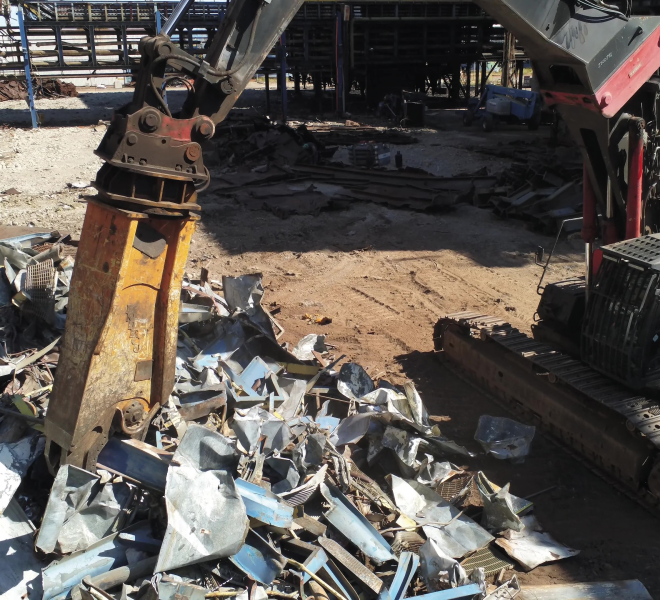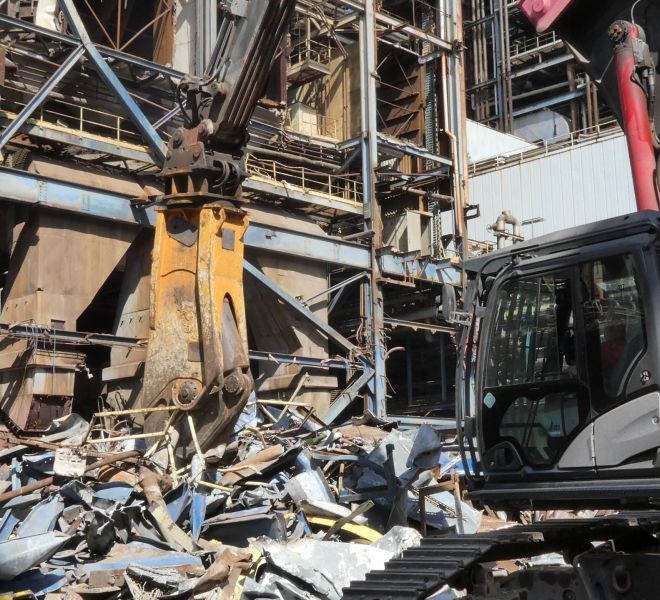Two Indeco shears for decommissioning the former Enel plant in Piombino
The section of the Bari-Barletta railway line that crosses Andria city centre is being moved below ground level, a project that involves digging a 3 km trench. Indeco hydraulic hammers are taking on the job of excavating the whole 250,000 cu m.
The decommissioning of the former Enel plant in Piombino is one of the largest and most complex construction sites of this type in Europe. Over 70,000 tons of steel to be demolished, reduced in volume and sent to the foundry. A commitment that sees Perino Piero Srl employ two Indeco ISS 20/30 and ISS 30/50 shears that, after months of hard and continuous work, are proving their value in the field. When we talk about the demolition of steel structures, we do not always have in mind the real operational difficulties of dealing with construction sites that have nothing ordinary about them. As in the case of the former Enel plant in Piombino where Perino Piero Srl, one of the most important Italian companies specialized in reclamation and demolition, has been working for about a year on the complete decommissioning. We are talking about one of the largest thermoelectric power plants in Italy. A plant that used to provide 1,280 MW of electrical power and that today has all the undisputed charm of great industrial architecture. Built in the early 70s, it started working in 1977 and 1978, with the launch of the first two groups of 320 MW each. In 1988 and 1989 the last two groups entered service. Therefore, we are talking about four sections powered by fuel oil operating in a Rankine cycle. The plants occupy a total of 40 hectares located within an area that extends for a total of about 140. The construction site, very complex both from an environmental and operational point of view, aims to return the area completely cleared and reclaimed for the subsequent construction of a large tourist facility. The plant deconstruction works began at the end of 2021 and are proceeding to schedule according to a plan for functional and complementary operations where demolitions and reclamation go hand in hand. And where two Indeco ISS 20/30 and ISS 30/50 shears play the leading role.
Environmental obligations
The former Enel plant in Torre del Sale is located within the Orti Bottagone wetland managed by the WWF. It is an interesting wildlife oasis where many bird species find refuge, including flamingos. The area has been expanded by another 12 hectares and is part of an overall framework of environmental enhancement. It is located by the sea where in the tankers that brought the fuel oil for the boiler’s operation used to dock in the ad hoc port opposite. At the edge of the port area stands the Torre del Sale, an ancient fortress erected in the late Middle Ages that served as a defence and sighting for the then Principality of Piombino. These are very stringent obligations that pose various technical difficulties for demolition within the construction site. This is why both boilers and chimneys will be demolished with techniques that are non-invasive and require machines and equipment appropriate to the task. For the boilers, we will proceed by emptying from below and the subsequent and gradual lowering of the elements with hydraulic jacks for the gradual demolition. The chimneys will instead require the use of specific mobile bridges to carry out a gradual and controlled lowering through demolition with small mechanical means. A technique that involves the demolition by degrees of the artefact with the disposal of the material inside the chimney. From here, it will then be possible to remove all the resulting material and send it for disposal or recycling through access to the base.
Reclamation and removal of plants
The removal of the plant systems is certainly the most spectacular operation. Here, there are machines and equipment in action that highlight their potential in a harsh and selective environment every day. We are talking about elements that are “off the scale” such as boilers, engine room, filters and chimneys that, at first glance, allow you to immediately understand the complexity and difficulty of the work. The numbers at stake are not easy to manage. We are in fact, talking about over 70,000 tons of steel to be demolished, reduced in volume and sent to the steel mill for complete recovery. Before the demolition of the artefacts, it is necessary to remove and dispose of any liquids still present in the plant. In addition to this, almost all plant elements are covered with insulating layers of stone wool. Material that must be encapsulated, removed, and disposed of with great care. The total figure exceeds 300,000 square metres of material to be treated, bagged and sent for disposal.
Steel as the protagonist
The operational phases of the construction site are conceptually simple. To date, in fact, the five tanks that contained the fuel oil for the operation of the boilers have been completely demolished. Four have a capacity of 50,000 cubic metres and one 100,000. The Indeco shears were, therefore, among the first ever to enter the scene. The ISS 20/30 is almost permanently installed on a Doosan DX340LCN-5 hydraulic excavator, while a Kiesel KMC600 demolition excavator uses the larger ISS 30/50. Both are constantly engaged in the demolition of the artefacts and in the subsequent cutting of the material for volume reduction. An Operation that facilitates the loading of material to be sent to the foundry.
A hard job with no let-up
The two pieces of equipment are subjected to very tight operational rhythms where, especially in the demolition phases, they are subject to very hard use. To safely and rationally demolish the plants, it is often necessary to move large elements. Operations that can heavily stress the two shears. In particular, the ISS 30/50 is the most stressed. But since its arrival at the construction site, it is still operating with the original blades. The ISS 20/30 is mainly engaged in cutting the demolished steel and dismantling the plants that conveyed the fuel oil to the boilers. “They are two pieces of equipment that we bought after a field test” explain Fabrizio and Giuliano Perino, the two brothers owners of the Turin company. “We had in fact rented the ISS 20/30 for a job to be carried out inside a plant in Turin. The machine was a real and positive surprise, and so we decided to buy it together with the ISS 30/50. The latter was even more surprising and is tackling gruelling work in the Piombino shipyard. It‘s shape that facilitates the demolition and displacement of large metal elements.” The shipyard was judged positively right from the start, as the Perino brothers explain, “We have very professional operators who, also thanks to our advice, try different types of equipment without having prejudices of any kind. We seek a continuous dialogue with them, asking for everyone’s opinions in order to increase the efficiency of the construction site. Well, the two Indecos were a success right from the start, and the fact that our collaborators use them so assiduously is a clear sign of appreciation. To date, we have not had the slightest problem, and the productivity is very high”.
A construction site organized with rationality and method
The Piombino shipyard is managed in a very rational and methodical way. The huge dimensions of the area and the plants require a meticulous organization to keep the complex decommissioning works running to schedule. To date, about 50 people are engaged on-site, including technicians, operators and reclamation workers. There are currently five hydraulic excavators in action with operating weights between 25 and 90 tons. Two of these are equipped with demolition arms capable of reaching maximum heights of 28 and 36 meters. In support, there are two industrial handlers that deal with both the loading of scrap metal on transport vehicles, and to assist in the handling of materials during the reclamation and demolition works. All machines are equipped with demolition equipment, including the two Indeco ISS 20/30 and ISS 30/50 shears. “These are two pieces of equipment that are proving to be fundamental for the construction site” underline Fabrizio and Giuliano Perino “They are constantly at the forefront and contribute in a fundamental way to the progress of the work. We are two people open to field experimentation. And both the ISS 20/30 and the ISS 30/50 brilliantly passed the test of the construction site. The demolition of this plant is a formidable battlefield for shears and the Indeco have fully demonstrated a value that we had heard about but had never used ourselves”









